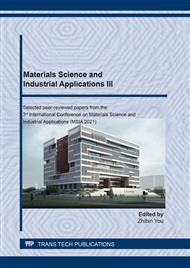[1]
J. Zhang, Z. Wang, A. Mishra, Intermediate phase enhances inorganic perovskite and metal oxide interface for efficient photovoltaics, Joule 4 (2020) 222-234.
DOI: 10.1016/j.joule.2019.11.007
Google Scholar
[2]
A. Kojima, K. Teshima, Y. Shirai, Organometal halide perovskites as visible-light sensitizers for photovoltaic cells, J. Am. Chem. Soc. 131 (2009) 6050-6051.
DOI: 10.1021/ja809598r
Google Scholar
[3]
Y. Chen, Y. Lei, Y. Li, Strain engineering and epitaxial stabilization of halide perovskites, Nature 577 (2020) 209-215.
Google Scholar
[4]
S.Q. Hu, J. Wang, J. Zhang, J.W. Lim, Y. Gao, S.G. Zhang, Engineering the electronic structure of perovskite oxide surface with ionic liquid for enhanced oxygen reduction reaction, Appl. Catal. B-Environ. 282 (2021) 119593.
DOI: 10.1016/j.apcatb.2020.119593
Google Scholar
[5]
Y. Zhou, H. Zhou, J. Deng, Decisive structural and functional characterization of halide perovskites with synchrotron, Matter 2 (2020) 360-377.
DOI: 10.1016/j.matt.2019.12.027
Google Scholar
[6]
J.H. Im, C.R. Lee, J.W. Lee, 6.5% efficient perovskite quantum-dot-sensitized solar cell, Nanoscale 3 (2011) 4088-4093.
DOI: 10.1039/c1nr10867k
Google Scholar
[7]
Y. Li, X. Wang, S. Wu, H. Ci, H. Xu, X. Li, H. Sun, Z. Zhang, A. Cao, X. Guo,Y. Li, Large-scale aligned crystalline CH3NH3PbI3 perovskite array films, J. Mater. Chem. A 3 (2015) 18847-18851.
DOI: 10.1039/c5ta04936a
Google Scholar
[8]
J. Chen, Z. Wan, J. Liu, S.-Q. Fu, F. Zhang, S. Yang, S. Tao, M. Wang, C. Chen, Growth of compact CH3NH3PbI3 thin films governed by the crystallization in PbI2 matrix for efficient planar perovskite solar cells, ACS Appl. Mater. Interfaces 10 (2018) 8649-8658.
DOI: 10.1021/acsami.7b18667
Google Scholar
[9]
N.T.K. Thanh, N. Maclean, S. Mahiddine, Mechanisms of nucleation and growth of nanoparticles in solution, Chem. Rev. 114 (2014) 7610-7630.
DOI: 10.1021/cr400544s
Google Scholar
[10]
X. Li, D. Bi, C. Yi, A vacuum flash-assisted solution process for high-efficiency large-area perovskite solar cells, Science 353 (2016) 58-62.
DOI: 10.1126/science.aaf8060
Google Scholar
[11]
W.Q. Wu, Q. Wang, Y. Fang, Molecular doping enabled scalable blading of efficient hole-transport-layer-free perovskite solar cells, Nat. Commun. 9 (2018) 1625.
DOI: 10.1038/s41467-018-04028-8
Google Scholar
[12]
S. Jeong, S. Seo, H. Shin, p-Type CuCrO2 particulate films as the hole transporting layer for CH3NH3PbI3 perovskite solar cells, RSC Adv. 8 (2018) 27956.
DOI: 10.1039/c8ra02556h
Google Scholar
[13]
I.S. Yang, J.S. You, S.D. Sung, C.W. Chung, J. Kim, W.I. Lee, Novel spherical TiO2 aggregates with diameter of 100 nm for efficient mesoscopic perovskite solar cells, Nano Energy 20 (2016) 272-282.
DOI: 10.1016/j.nanoen.2015.12.031
Google Scholar
[14]
S. Ye, H. Rao, Z. Zhao, A breakthrough efficiency of 19.9% obtained in inverted perovskite solar cells by using an efficient trap state passivator Cu(thiourea)I, J. Am. Chem. Soc. 139 (2017) 7504-7512.
DOI: 10.1021/jacs.7b01439
Google Scholar
[15]
J.C. Yu, S. Badgujar, E.D. Jung, Highly efficient and stable inverted perovskite solar cell obtained via treatment by semiconducting chemical additive, Adv. Mater. 31 (2018) 1805554.
DOI: 10.1002/adma.201805554
Google Scholar
[16]
Y. Bai, H. Chen, S. Xiao, Effects of a molecular monolayer modification of NiO nanocrystal layer surfaces on perovskite crystallization and interface contact toward faster hole extraction and higher photovoltaic performance, Adv. Funct. Mater. 26 (2016) 2950-2958.
DOI: 10.1002/adfm.201505215
Google Scholar
[17]
K.M.M. Salim, T.M. Koh, D. Bahulayan, Extended absorption window and improved stability of cesium-based triple-cation perovskite solar cells passivated with perfluorinated organics, ACS Energy Lett. 3 (2018) 1068-1076.
DOI: 10.1021/acsenergylett.8b00328
Google Scholar
[18]
Q. Jiang, Y. Zhao, X. Zhang, Surface passivation of perovskite film for efficient solar cells, Nat. Photonics 13 (2019) 460-466.
DOI: 10.1038/s41566-019-0398-2
Google Scholar
[19]
Y. Liu, Q. Dong, Y. Fang, Fast growth of thin MAPbI3 crystal wafers on aqueous solution surface for efficient lateral-structure perovskite solar cells, Adv. Funct. Mater. 29 (2019) 1807707.
DOI: 10.1002/adfm.201807707
Google Scholar


